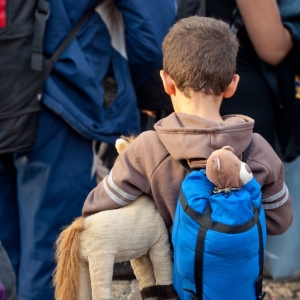Indicators in this domain assess the extent to which migrants have the same status as citizens in terms of access to basic social services such as health, education, and social security. It also describes the rights of migrants to family reunification, to work, and to residency and citizenship. The ratification of the main international conventions is also included within this domain.
Indicators in this category look at the extent to which migrants have access to certain social services such as health, education and social security. They also examine measures to ensure integration and access to work.
Indicators in this domain assess countries’ institutional, legal, and regulatory frameworks related to migration policies. Domain 2 also reviews the existence of national migration strategies that are in-line with development, as well as institutional transparency and coherence in relation to migration management. This domain also investigates the extent to which governments collect and use migration data.
Indicators in this category assess the institutional frameworks of cities for migration. This area also examines the existence of migration strategies consistent with development objectives, as well as institutional transparency and coherence in migration management.
This domain focuses on countries’ efforts to cooperate on migration-related issues with other states and with relevant non-governmental actors, including civil society organizations and the private sector. Cooperation can lead to improvements in governance by aligning and raising standards, increasing dialogue and providing structures to overcome challenges.
Indicators in this category focus on cities’ efforts to cooperate on migration issues with the national government as well as other cities and relevant non-governmental actors, including civil society organizations and the private sector.
This domain includes indicators on countries’ policies for managing the socioeconomic well-being of migrants, through aspects such as the recognition of migrants’ educational and professional qualifications, provisions regulating student migration and the existence of bilateral labour agreements between countries. Indicators equally focus on policies and strategies related to diaspora engagement and migrant remittances.
Indicators in this category assess cities’ initiatives in terms of international student mobility, access to the labour market and decent working conditions for migrant workers. Aspects related to diaspora engagement and migrant remittances are also included in this domain.
This domain studies the type and level of preparedness of countries when they are faced with mobility dimensions of crises, linked to either disasters, the environment and/or conflict. The questions are used to identify the processes in place for nationals and non-nationals both during and after disasters, including whether humanitarian assistance is equally available to migrants as it is to citizens.
Indicators in this category examine the type and level of readiness of cities to deal with aspects of mobility crises. The questions focus on the processes in place for citizens and non-citizens both during and after disasters, especially if humanitarian assistance is available for migrants and citizens.
This domain analyses countries’ approach to migration management in terms of border control and enforcement policies, admission criteria for migrants, preparedness and resilience in the case of significant and unexpected migration flows, as well as the fight against trafficking in human beings and smuggling of migrants. It also assesses efforts and incentives to help integrate returning citizens.
Indicators in this category look at the cities’ approaches to migrant safety as well as return and reintegration policies and the fight against trafficking in persons.
This local Profile describes examples of well-developed areas of the County of Mombasa (Kenya) migration governance structures and areas with potential for further development, as evaluated through the six domains of the Migration Governance Indicators (MGI). These address migrants’ rights, a “whole-of-government” approach, partnerships, socioeconomic well-being of migrants, the mobility dimensions of crises, and safe and orderly migration.
Click the icons on the wheel to explore the key findings.
The Migration Governance Indicators (MGI) initiative is a policy-benchmarking programme led by the International Organization for Migration (IOM) and implemented with research and analysis from the Economist Intelligence Unit. Funding is provided by IOM Member States.
Migration Governance: examples of well-developed areas
- The County Government of Mombasa (CGM) manages an online portal that allows both residents and migrants to access services, including issuance of business permits or routine vaccination services.
- The CGM’s Public Participation Policy (2020) aims to involve all residents, including migrants, in collaboration and dialogue on local government affairs and policy.
- The CGM collaborates with the State Department for Social Protection on child protection issues, including those relating to migrant children.
Areas with potential for further development
- There are no clear guidelines for migrants to access social housing in Mombasa County.
- The CGM provides cultural mediation services to help resolve disputes between migrant populations, and between local residents and migrant populations only on an ad hoc basis.
Migration Governance: examples of well-developed areas
- The County Government of Mombasa (CGM) participates in the National Coordination Mechanism on Migration dialogue through the Council of Governors.
- The CGM provides basic information regarding its municipal public services that are also accessible to migrants through the eServices Portal.
- County public servants receive regular trainings, including on gender and development, as well as on migrants’ rights.
Areas with potential for further development
- The CGM does not have an agency or department responsible for designing migration policies or strategic plans.
- There is no local-level coordination mechanism on migration issues.
Migration Governance: examples of well-developed areas
- The County Government of Mombasa (CGM) engages with its residents and civil society organizations in agenda-setting and the implementation of migration-related policies.
- The CGM collaborates on migration issues with different United Nations agencies.
- In 2021, the CGM developed a policy on resilience and prevention of violent extremism, which aims to address issues such as the migration dimension of radicalization and violent extremism.
Areas with potential for further development
- The CGM has limited formal engagement with migrant associations, the private sector, or members of its diaspora and expatriate communities in the county in agenda-setting and the implementation of migration-related programmes and policies.
- The county does not have bilateral programmes related to migration with neighbouring counties.
Migration Governance: examples of well-developed areas
- The County Government of Mombasa (CGM) runs financial literacy and skills training programmes and offers rehabilitation programmes that are also accessible to migrants.
- The CGM Investment Authority Bill (2019) targets potential foreign investors in Mombasa and outlines support, including assistance in procuring authorizations, permits and licenses to facilitate investments.
Areas with potential for further development
- The county has no specific measures to promote gender equality for migrant workers.
- The Mombasa Social Protection Strategy (2018) and Mombasa Integrated Development Plan (2018-2022) do not include measures to facilitate remittance flows and promote the financial inclusion of migrants and their families.
Migration Governance: examples of well-developed areas
- The County Government of Mombasa’s (CGM) Climate Change Policy (2021) recognizes the impact of “population displacement and migration from climate disaster prone areas especially the slums” and includes strategies to address this.
- The CGM has in place contingency plans, such as temporary relocation, to manage large-scale population movements in times of crisis.
- The CGM has put in place early warning mechanisms that are also accessible to migrants in case of crises.
Areas with potential for further development
- The CGM Disaster Preparedness and Emergency Management Act does not establish any provisions to address the specific needs of migrants and displaced persons.
- There are no coordination agreements, partnerships or referral systems in place in the CGM to assist migrants in the case of local emergencies.
Migration Governance: examples of well-developed areas
- Local public servants of the County Government of Mombasa (CGM) receive training courses on migrants’ rights and migration regulations by national agencies.
- In collaboration with the national Government, Mombasa County facilitates migrants’ return and reintegration.
Areas with potential for further development
- There are no provisions for migrant reintegration in the CGM Integrated Development Plan (2018–2022).
- The CGM does not have a local strategy to combat human trafficking.
- The CGM does not have any measures in place to combat migrant labour exploitation.




